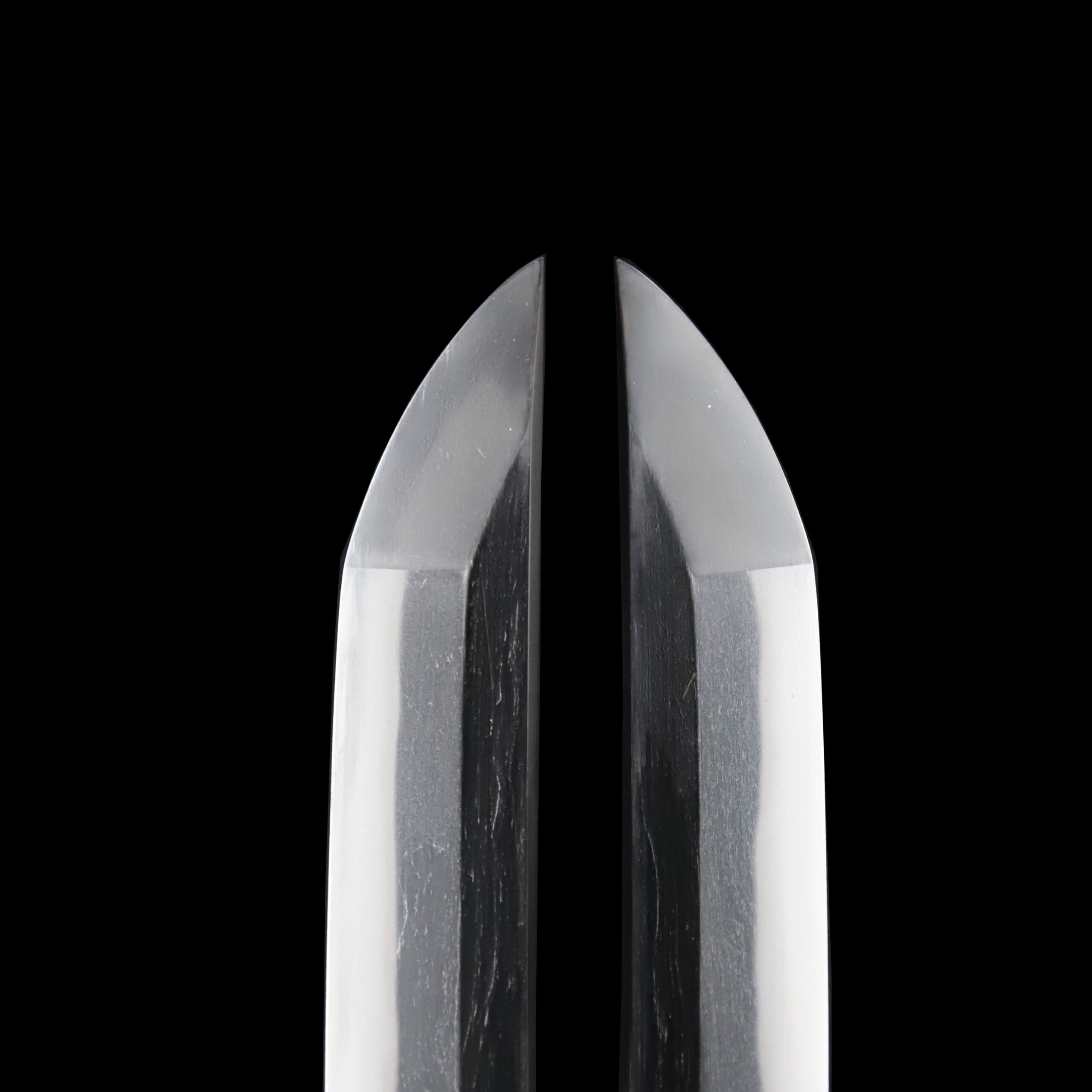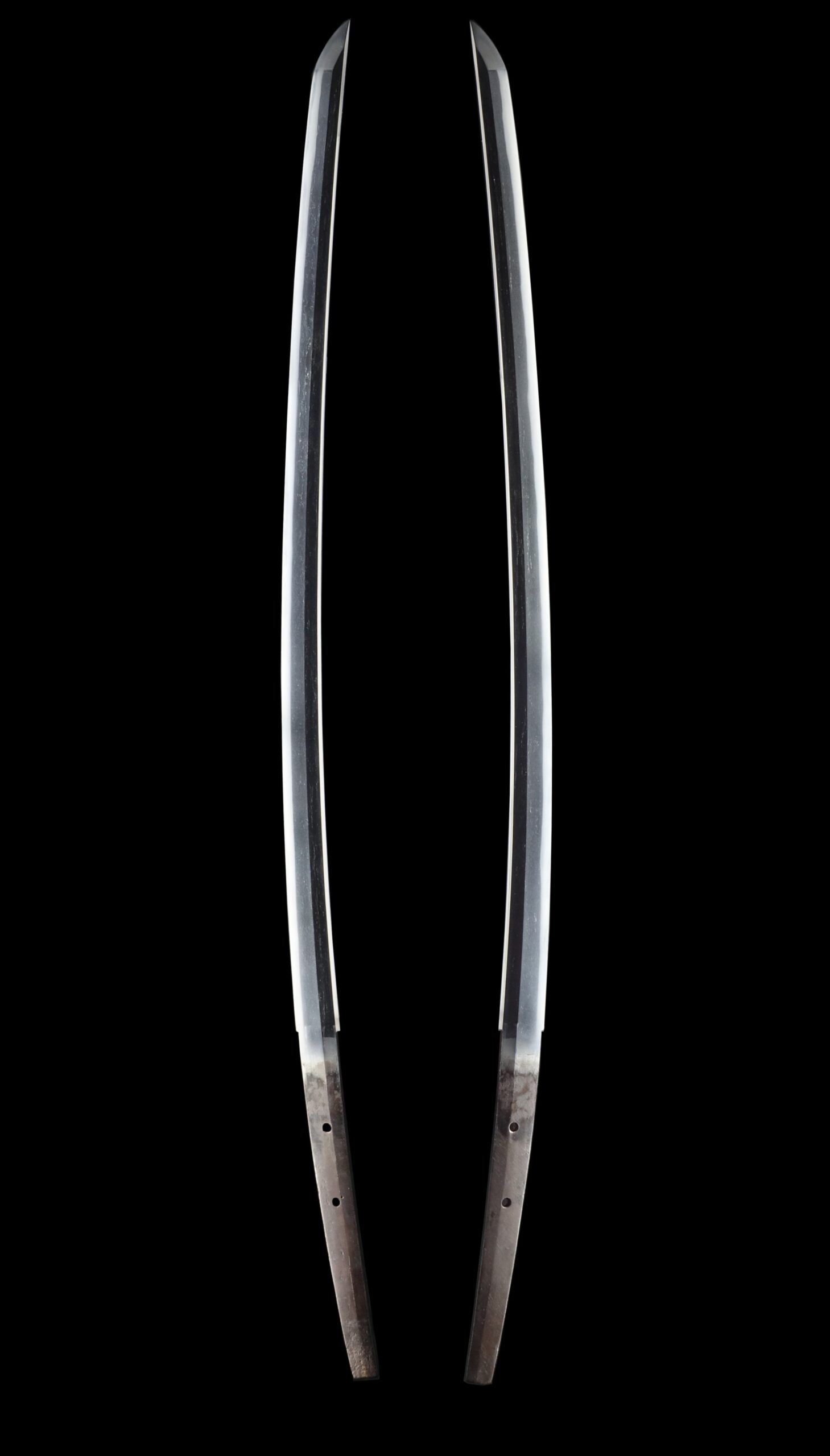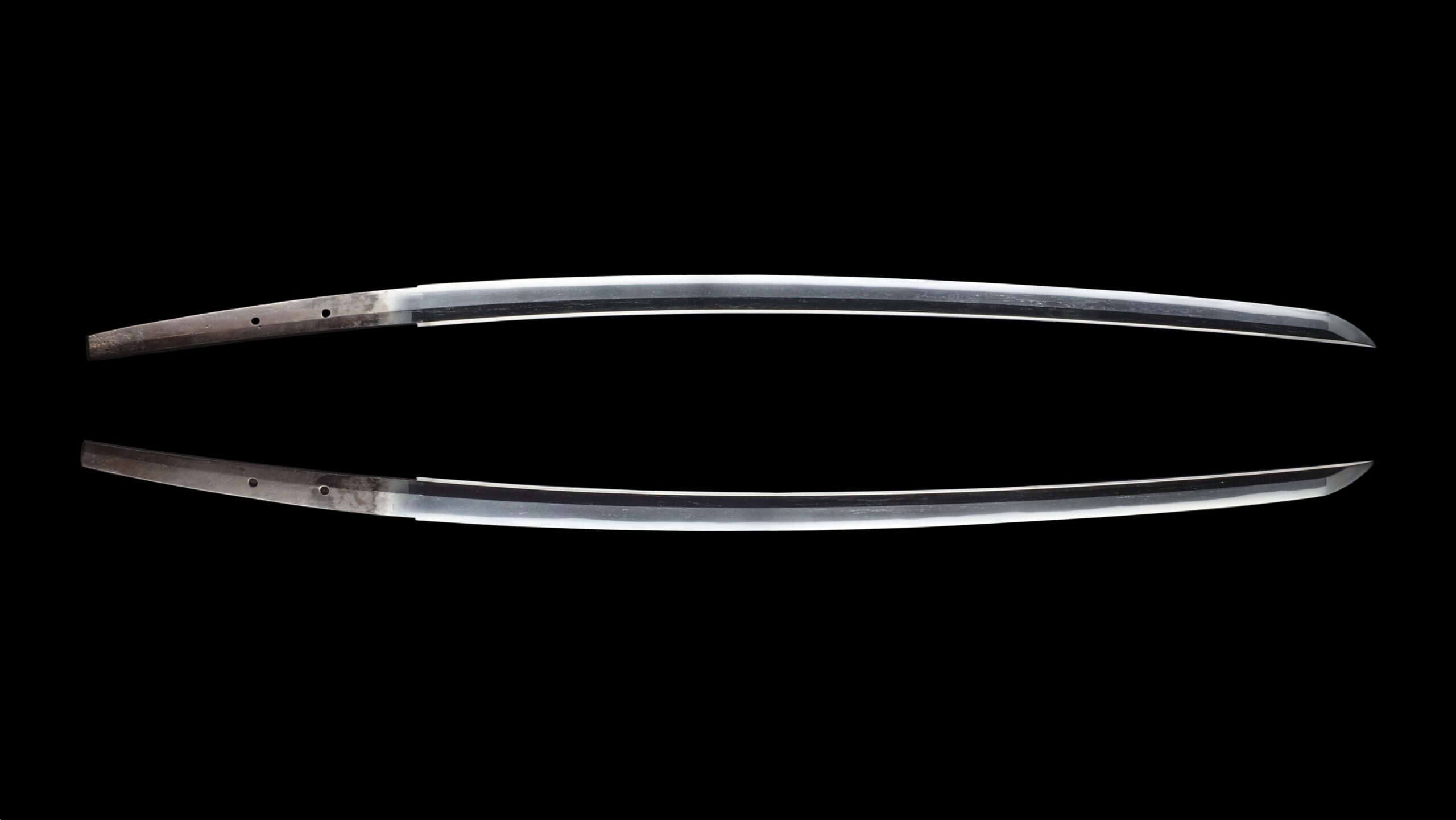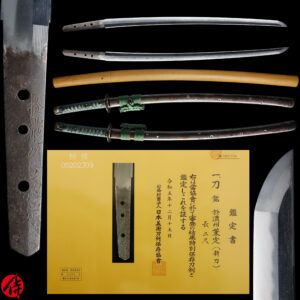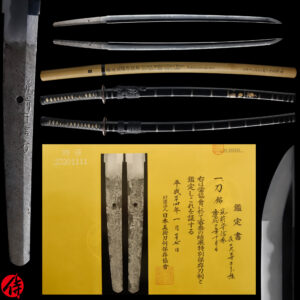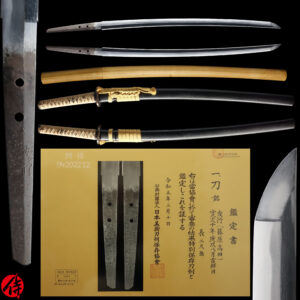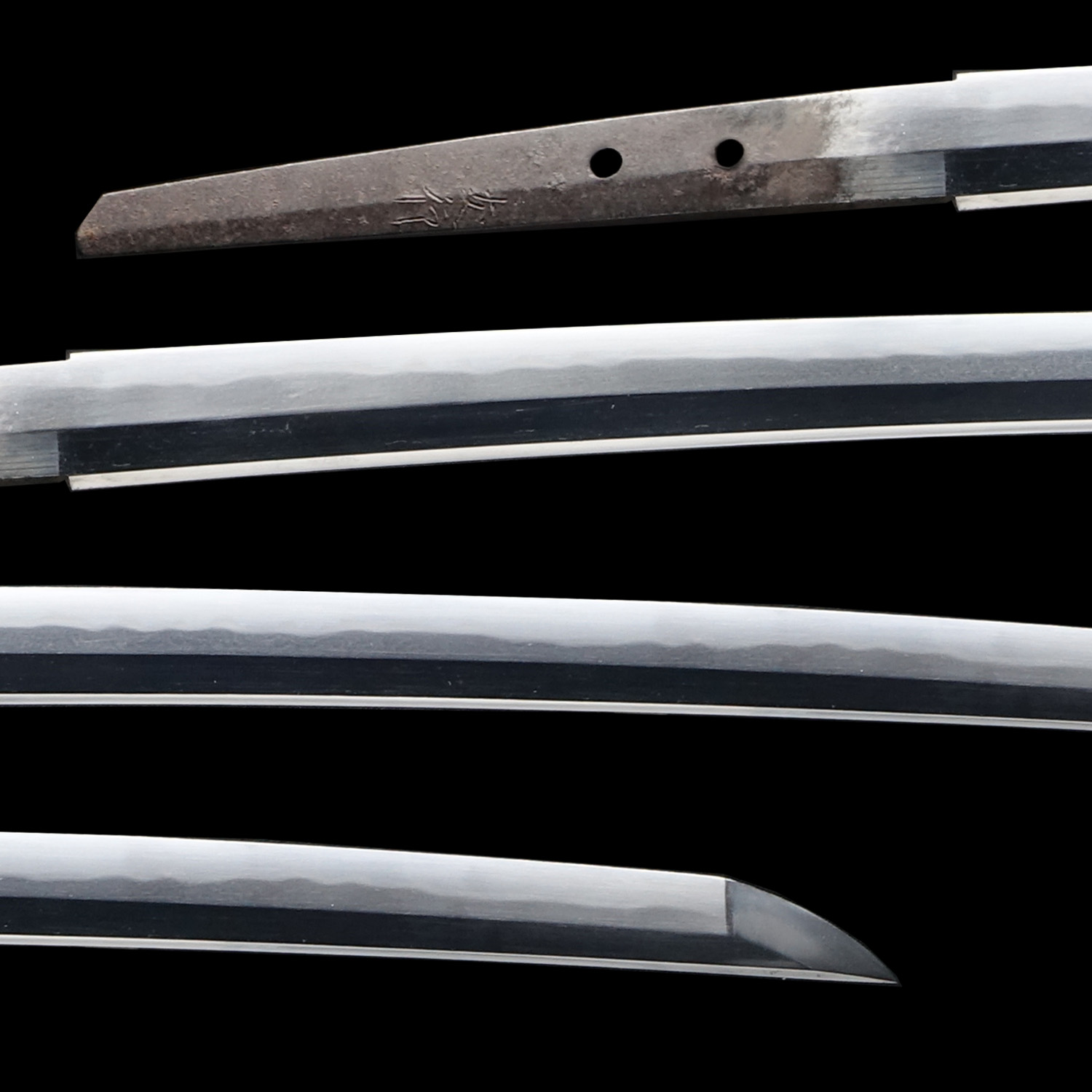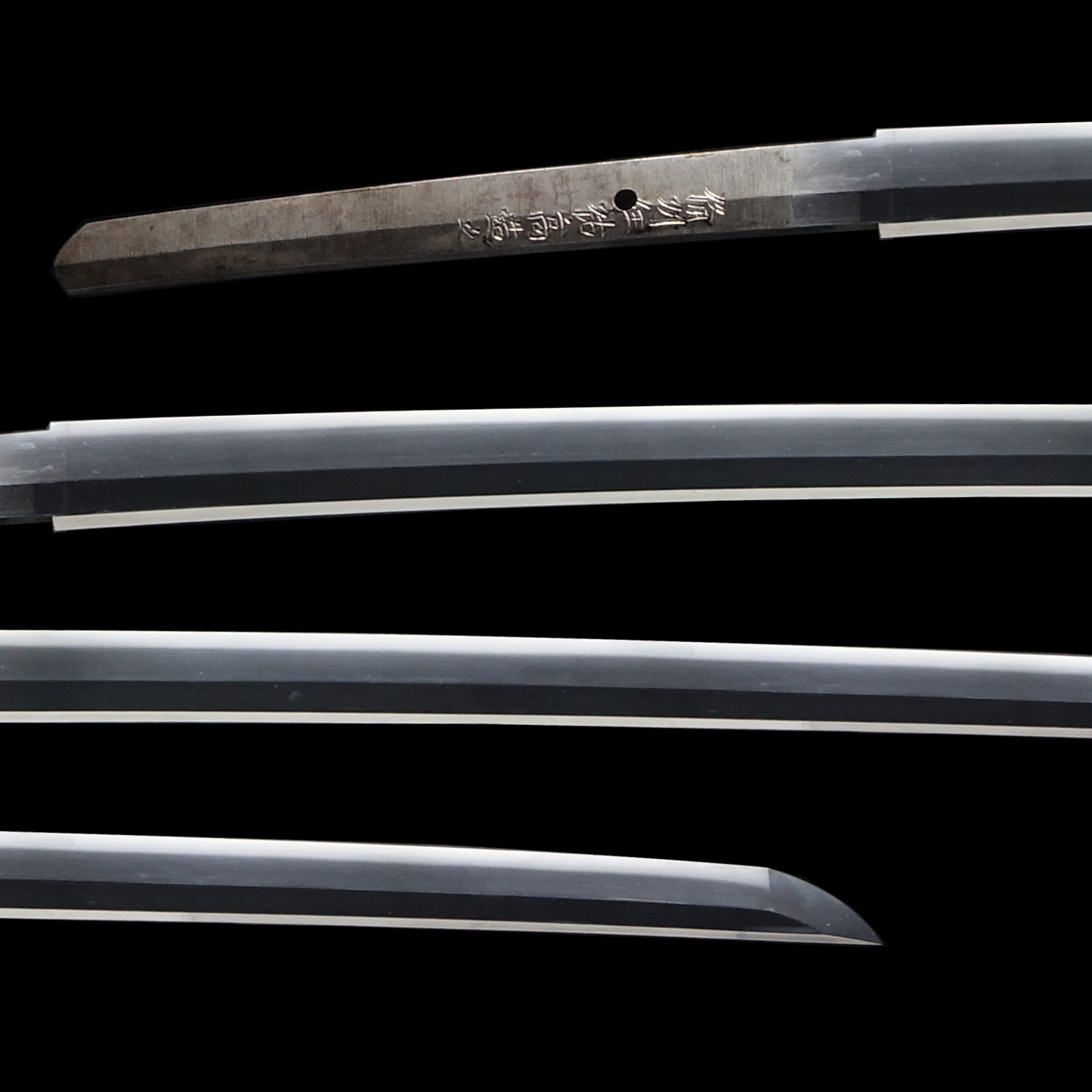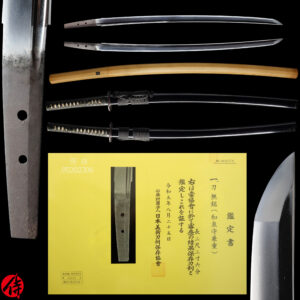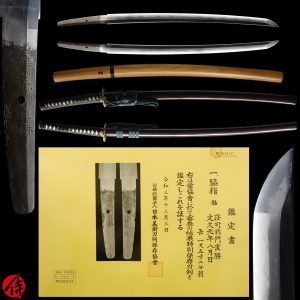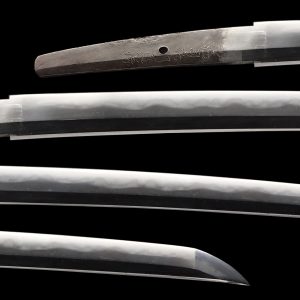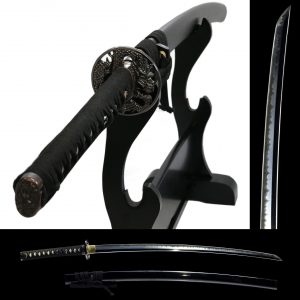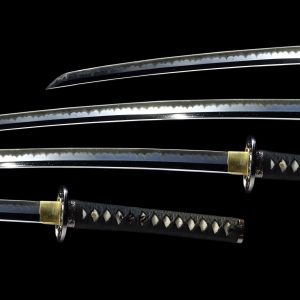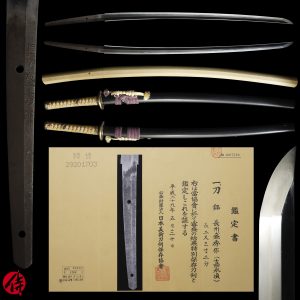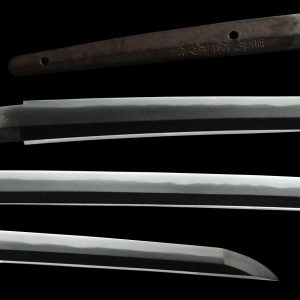Antique Japanese Sword Katana attributed to Chiyozuru with NBTHK Hozon Certificate
【Description】
This blade is attributed to Chiyozuru school(千代鶴). It is estimated it was forged during the last years of the Nanbokucho-early Muromachi period(late 14th century-early 15th century).
Chiyozuru school
The founder of Chiyozuru school was Kuniyasu(國安). It is said that Kuniyasu was the grandson of Kunimatsu, a younger brother of Rai Kunitoshi. Rai Kunitoshi was one of the most famous swordsmiths in Yamashiro province(Kyoto).
Kuniyasu is known as the prominent figure of the Echizen Rai school. Kuniyasu was forging swords in Yamashiro province but moved to Echizen prefecture and founded Chiyozuru school. The name of Chiyozuru(千代鶴) came from the fact that Kuniyasu’s name during his childhood was Chiyozurumaru.
The school prospered during the last years of the Nanbokucho-early Muromachi period(late 14th century-early 15th century).
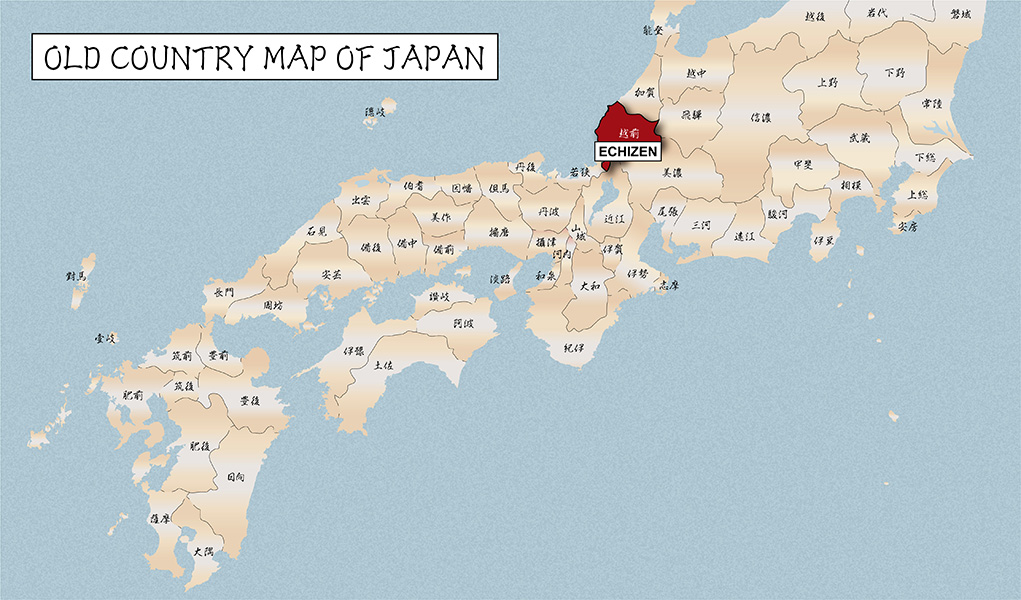
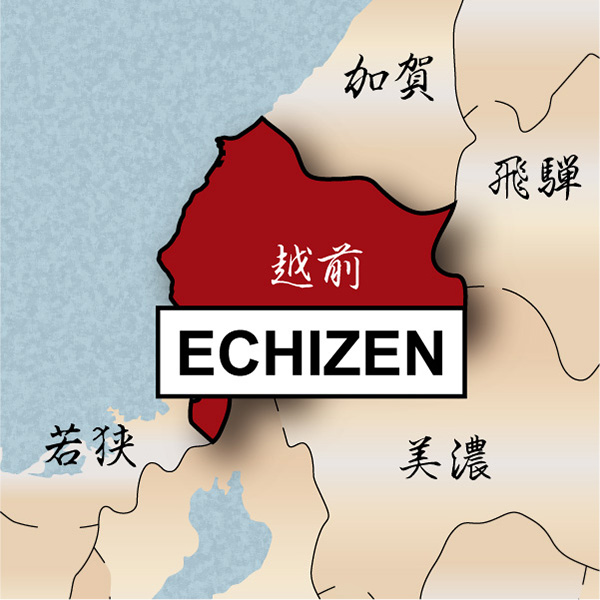
Rai school&Yamashiro province
Yamashiro province was famous for its sword-making style called YAMASHIRO-DEN. YAMASHIRO-DEN’s origin dates back to the Heian period(794 A.D), when the capital city was moved from Nara to Kyoto. The swordsmiths in Yamashiro province initially prospered by forging swords for court nobles and imperial families. Later on, they also forged swords for feudal lords after Samurai military government took control of Japan. There are so many renowned swordsmiths from this region.
It is said that the founder of YAMASHIRO-DEN was Sanjo Munechika. And there are seven prestigious schools in this region. One of them is Rai school is one of the most prestigious ones among YAMASHIRO-DEN. And swords forged by members of Chiyozuru school have characteristics of Rai school.
The significance of the school’s name
Chiyo(千代) means one thousand years, and Zuru(Tsuru:鶴) means crane in Japanese. The name Chiyozuru sounds very auspicious in Japanese. Therefore, the sword forged by this school were popular for any ceremony or events such as weeding from ancient times.
There is a proverb that says cranes and turtles live a long life. It says cranes have even one thousand years lifespan; therefore, cranes and turtles have been considered as the symbol of longevity since a long time ago. Also, as cranes make compatible couples, it represents happy marriage.
This blade is appraised as a Hozon Touken (保存刀剣) issued by NBTHK (Nihon Bijutsu Touken Hozon Kyokai: 日本美術刀剣保存協会). This authentication paper was only given to authentic Japanese swords, well preserved and high quality with artistic value.
Please keep in mind that there are a couple of visible Kitae Kizu on this blade. If you like to see the detailed condition before placing an order, please make sure to ask us to send you additional photos first.
【Blade】
Cutting Edge Length (Nagasa): 68.6 cm ( 27.0 inches)
Curvature (Sori): 1.6 cm (0.63 inches)

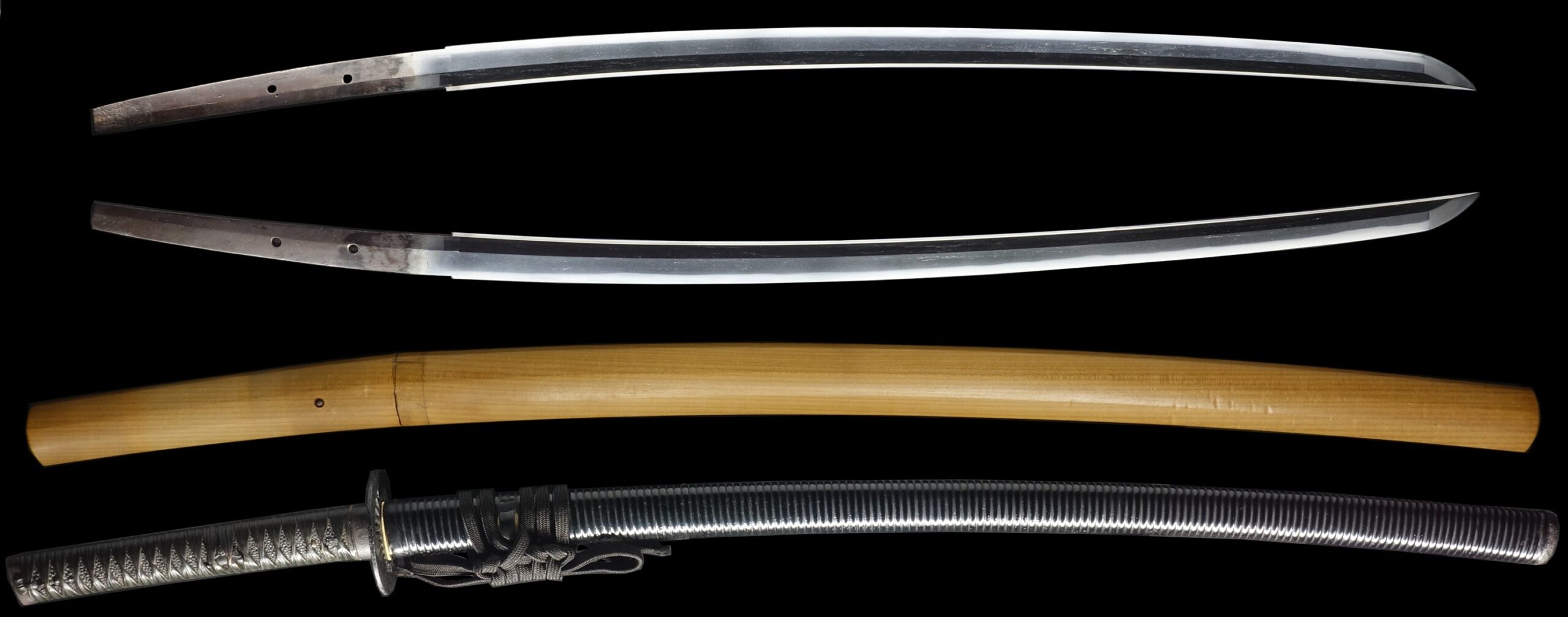
Hamon:
The crystalline structure which forms along the cutting edge of a blade as a result of the hardening process.
Jimon (Jihada):
Visible steel surface pattern created by folding and hammering during forging process.
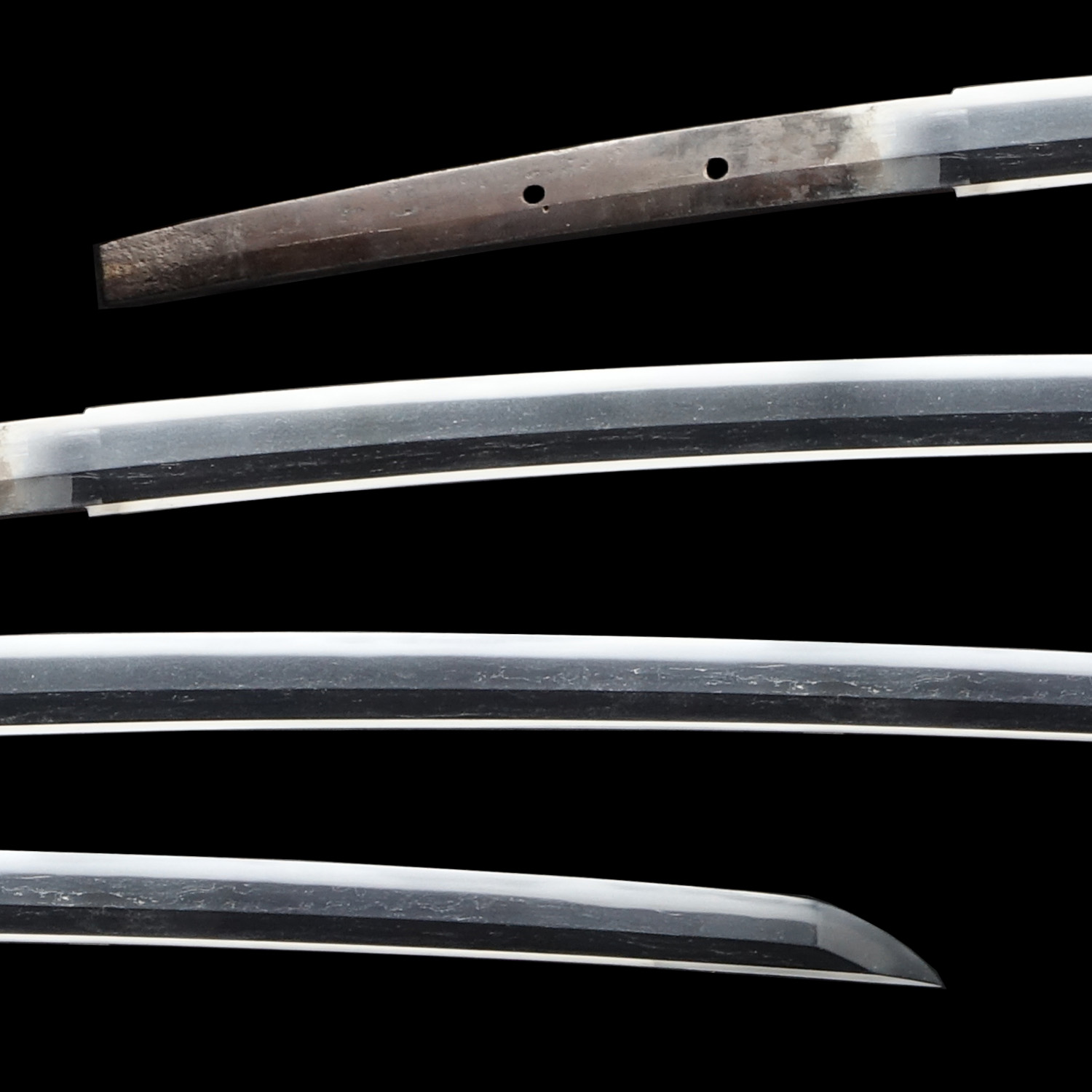
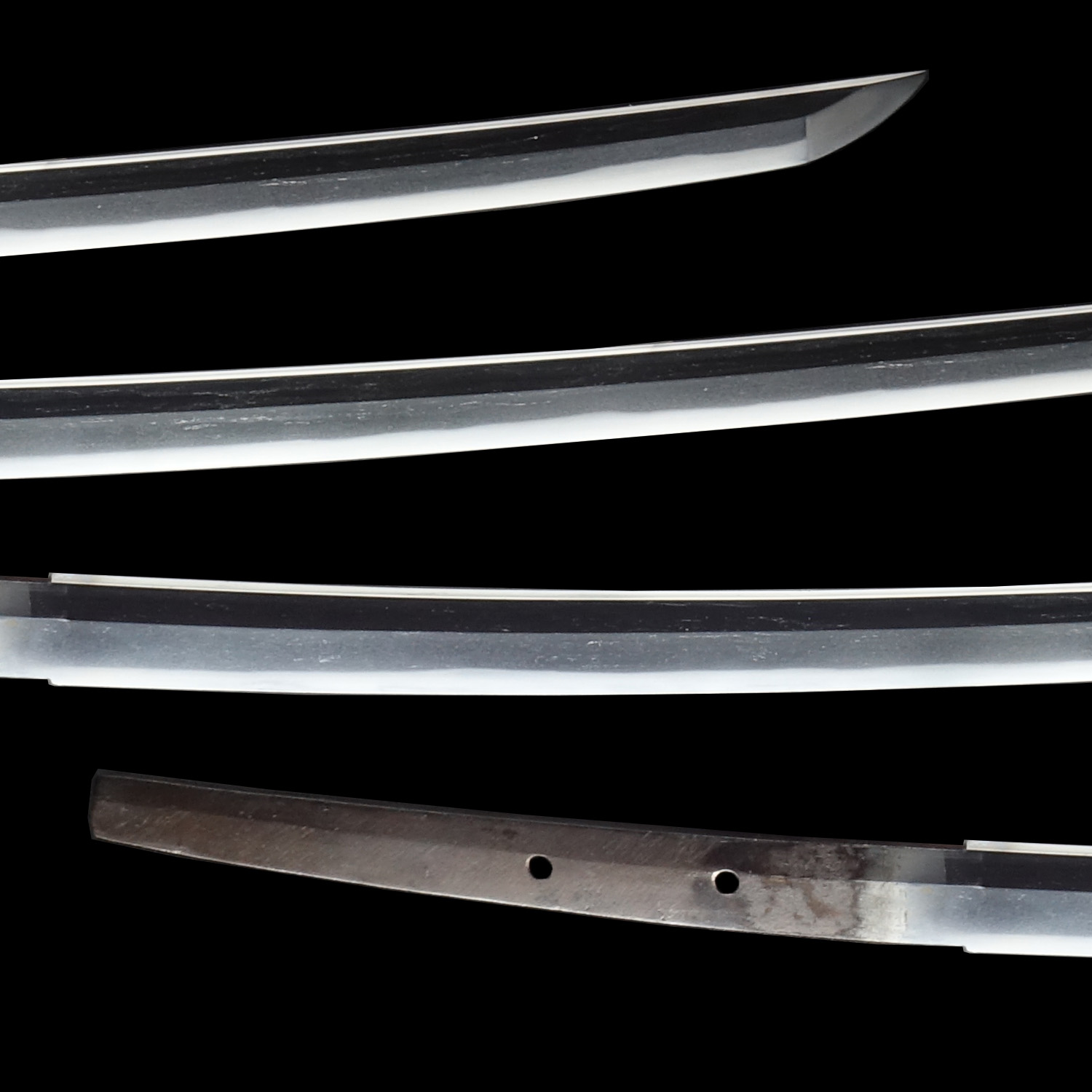

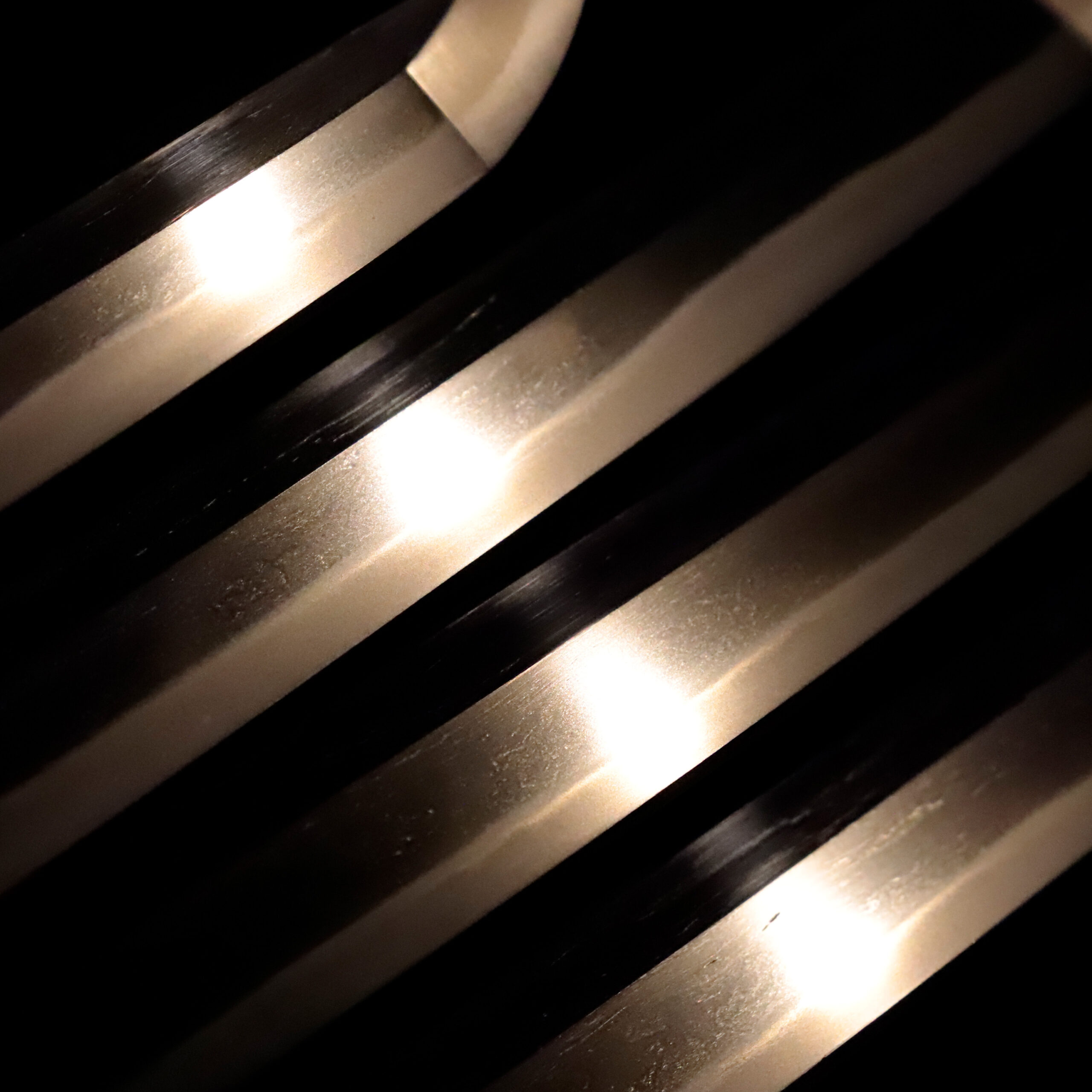

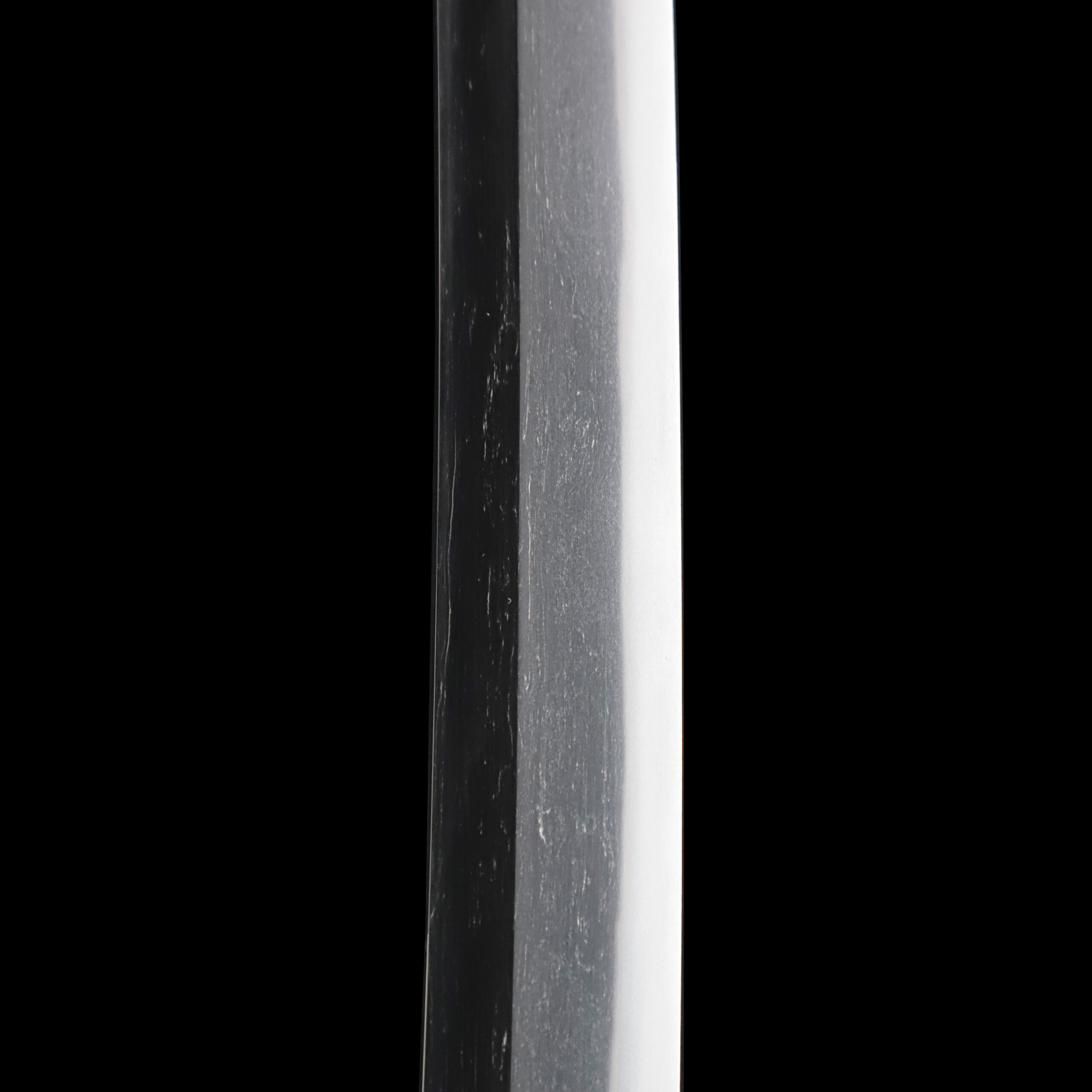
Kissaki: Kissaki is the tip of the Japanese sword.

Nakago: Nakago is the tang of the Japanese sword.
Japanese swordsmiths left the black rust on the tang because it prevents red rust while the tang is in its handle. And the discoloration of the tang was created over time, and it is a great indicator for a Japanese sword specialist to estimate when the sword was forged.
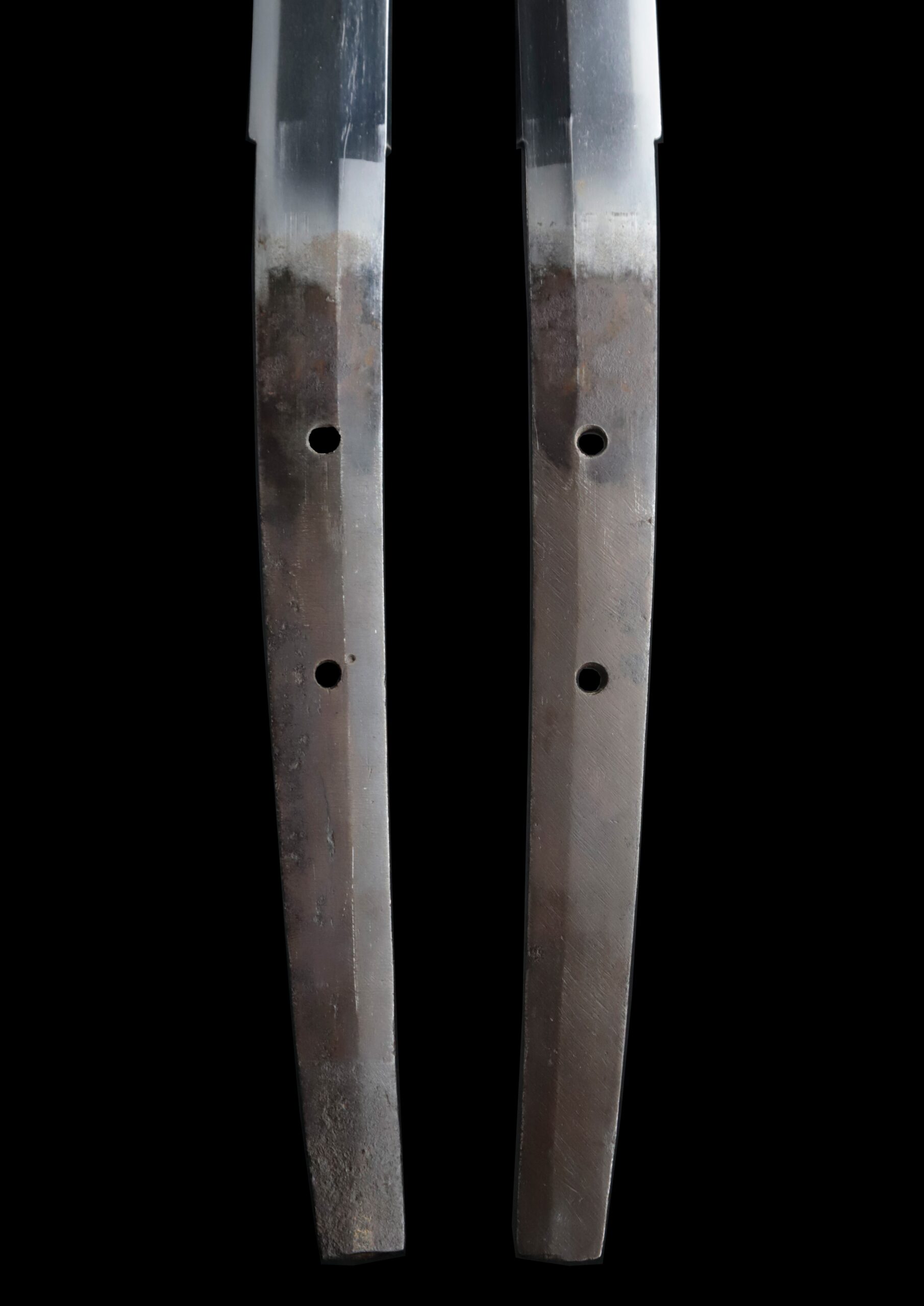
Koshirae: Koshirae is the mounting of the Japanese sword. There are several parts that consist of Koshirae such as Saya (Scabbard), Tsuka (Handle), Tsuba (Handguard).
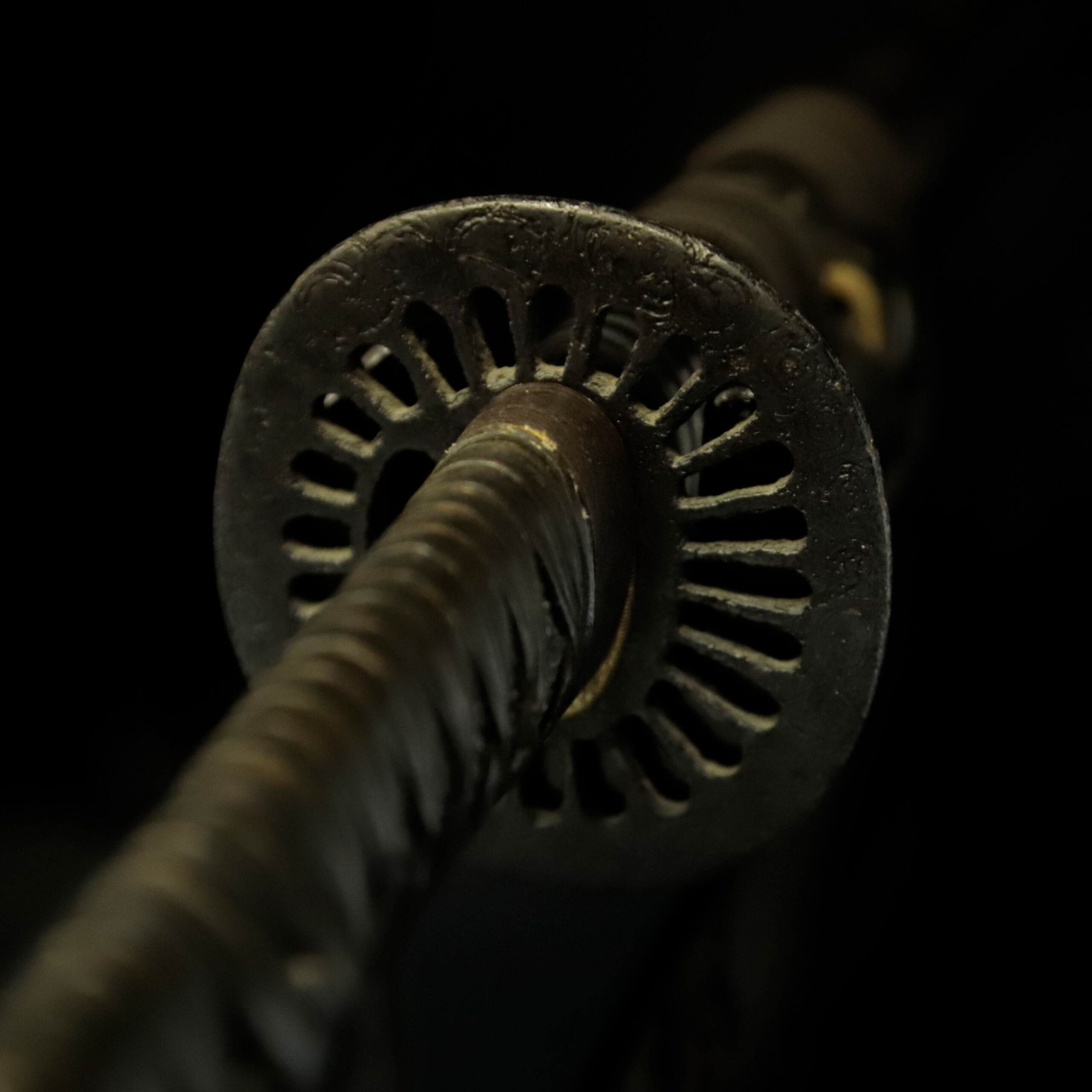
Fuchi-Kashira: A pair of matching sword fittings that cover the upper and bottom parts of its sword hilt.
We could see several marks are engraved on this Fuchi Kashira. We assume each of them was designed as a family crest. We believe one of these family crests on the Fuchi part is a Fuji (藤, wisteria) pattern called the Sagari-Fuji (下り藤). It depicts a round shape of a wisteria flower cluster hanging down. Since wisterias have strong fertility and grow being entwined with other trees, people regarded this flower as a symbol of longevity and prosperity for future generations.
Also, its Japanese name, Fuji, is likened to another word, Fushi (不死), which means immortality. According to a theory, that is why the Fujiwara (藤原) family, who reached the height of glory in the Heian (平安, 794-1185) period, used this motif for their family name and family crest. It is said there were Samurai families who used Fuji-designed family crests due to the admiration of the Fujiwara clan, which once occupied most of the upper aristocrats. Also, it might be because they wanted to share the prosperity of the Fujiwara clan.
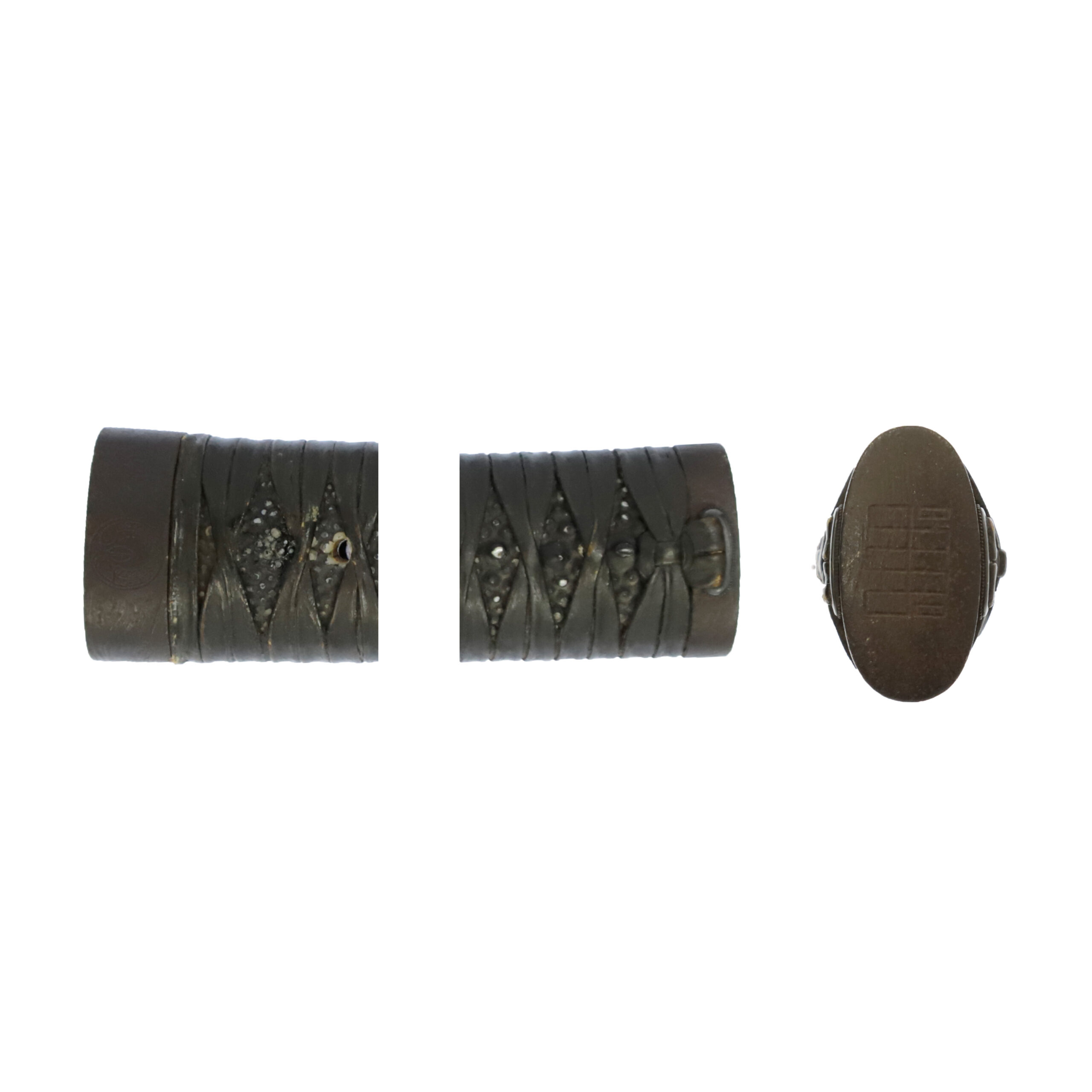
Tsuka and Menuki: Tsuka is the handle of the Japanese sword and Menuki is its decoration.
You would find the figure of a man-designed Menuki through the gaps of the Tsukamaki thread. We think one of the members of Shichifukujins (七福神, the Seven Gods of Good Fortune), Hoteison (布袋尊), was modeled. Hotei is a legendary priest in ancient China. According to a theory, Hotei is the incarnation of Miroku Bosatsu (弥勒菩薩, the Bodhisattva Maitreya). He has an obese body and brings a big sack that is full of treasures. He was always in contact with people with a smile and gave his prizes to religious people. Due to his mild-mannered attitude, he was surrounded by children and became a topic of people’s conversations. And then, he was started to be treated as a theme in paintings or poetry. Still today, he is gathering people’s faith as the symbol of happiness, happy marriage, and prosperity for future generations.
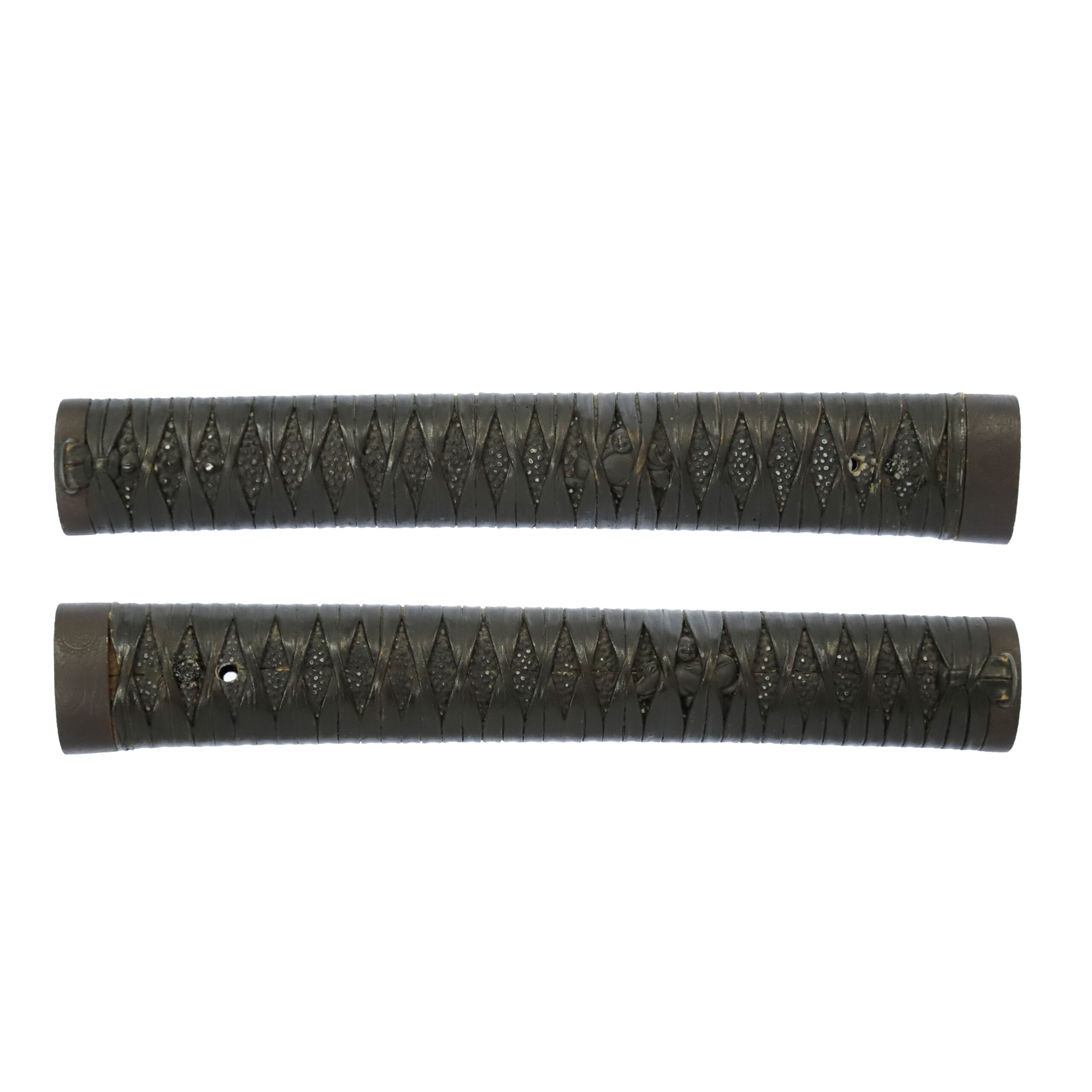

Tsuba and Habaki: Tsuba is the handguard for the Japanese Sword and Habaki is the equipment to make the blade not touch its scabbard inside. It prevents the blade from getting rusty and chipped.
The same elongated shapes are engraved with the openwork inside of the edge. We think it expresses a Kikuka (菊花, chrysanthemum flower) pattern in an abstract design. The chrysanthemum symbolizes autumn, and people have greatly appreciated it since ancient times. This flower has been likened to the sun as its petals form radially. That is why this flower pattern is treated as the symbol of perpetual youth and longevity or good health.
If you focus on the Mimi (耳, edge) part, you will find that irregular cloud-like patterns are engraved. Whilw the surface of this Tsuba has worn due to aging, it seems its entire surface is decorated with this design. Clouds bring rain and snow, and their movements significantly affect the day’s weather. Due to its supernatural power, a theory says that gods, spirits, and dragons dwell in the clouds. The cloud pattern has been associated with magical power, and people thought it an omen of lucky things. In addition, some people wish to have a leisurely life in comfort by seeing the movements of clouds. Also, as clouds appear repeatedly, cloud design represents reincarnation. Samurai warriors were always on the verge of life and death on the battlefields. They might have believed in the power of this pattern. And they had incorporated it into the design of their sword mountings, such as Tsuba.
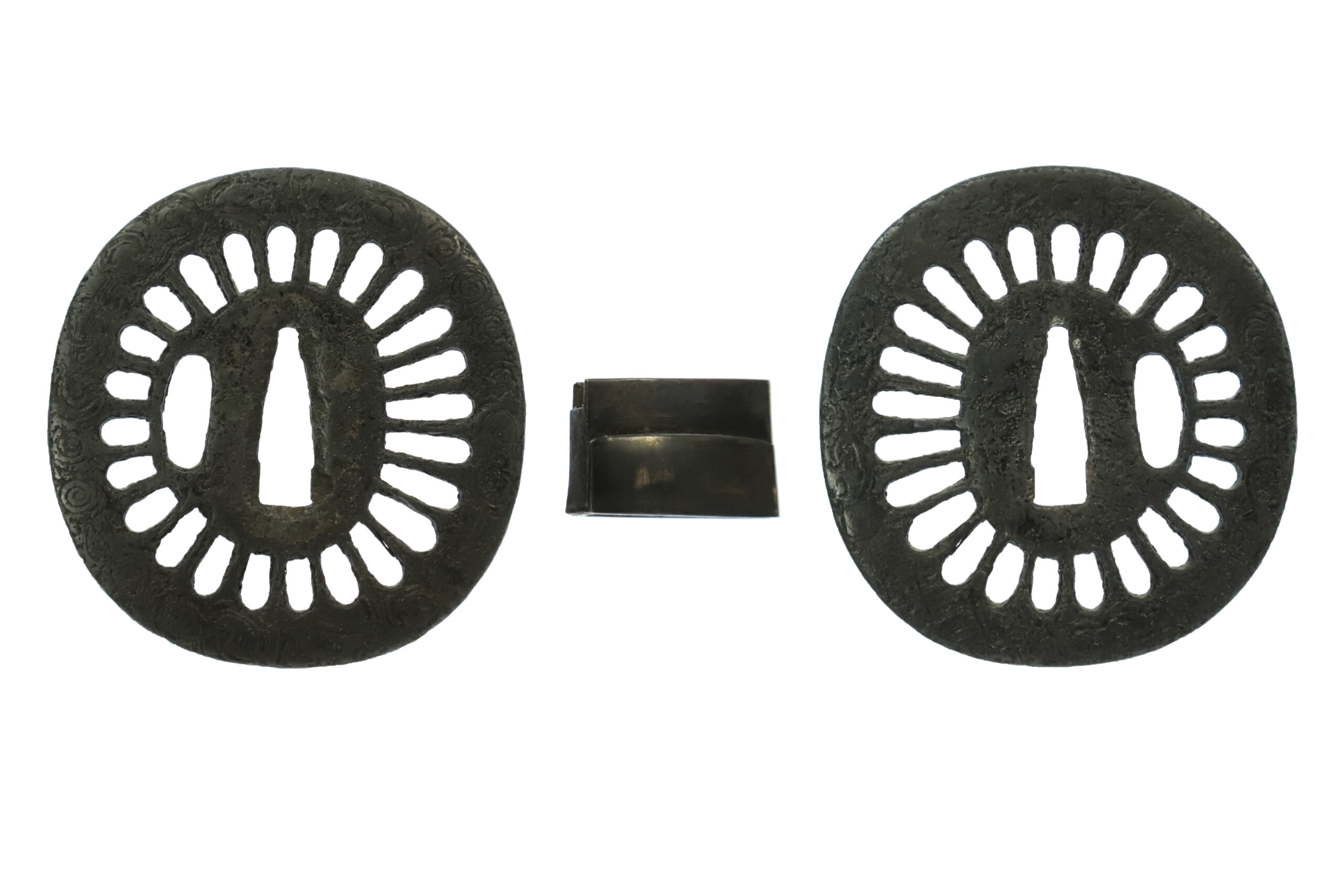
Saya: Saya is the scabbard for the Japanese sword.
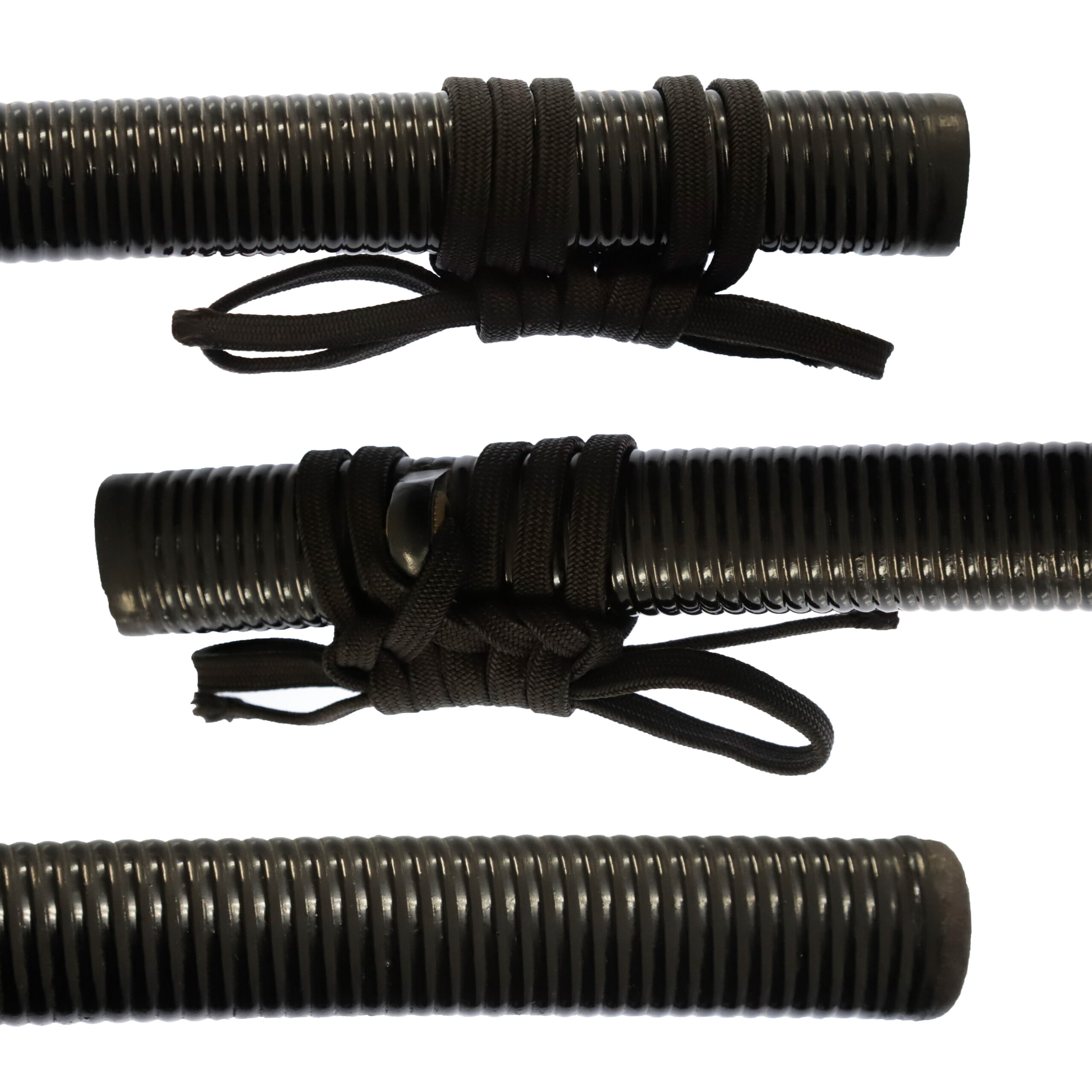
Authentication Paper: NBTHK Hozon Certificate for the blade (No.3032886)
NBTHK, also known as Nihon Bijutsu Touken Hozon Kyokai (the Society for the Preservation of the Japan Art Sword), is one of the oldest Japanese sword appraising organizations in modern-day Japan. They authenticated the blade on Dec 15th in the 5th year of Reiwa (2023). They appraised it as Hozon Touken, the blade worth preserving for Japanese society. The purchaser will receive this original certificate as well. We can also translate what is written into English and make a PDF file for your record if you request.
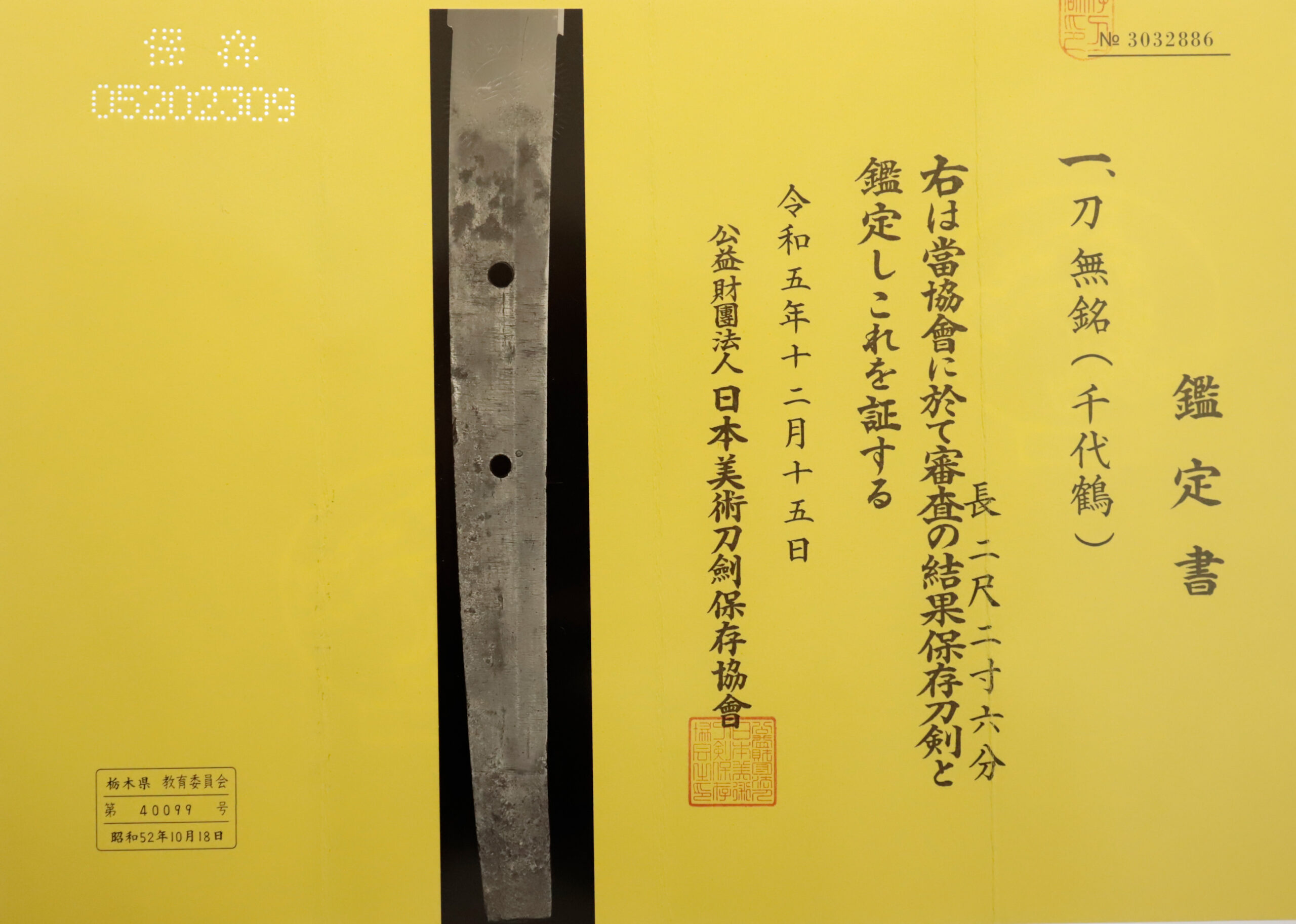
Registration Number: Tochigi 40099
The Board of Education in Tochigi prefecture issued a registration paper for this sword. It is called Jyu Token Rui Torokusho (銃刀剣類登録証). Bunkacho (The Agency for Cultural Affairs) acknowledges a Japanese sword with this paper as a work of art.
The sword needs to be traditionally hand-forged and made of Tamahagane carbon steel to be registered in the system. With this paper, its owner in Japan can legally own an authentic Japanese sword. Based on this registration number, we will apply for its export permit.
This paper will need to be returned to the board of education when the sword is being shipped abroad, but you can receive a copy of it. An English translation of this registration paper is available on request.
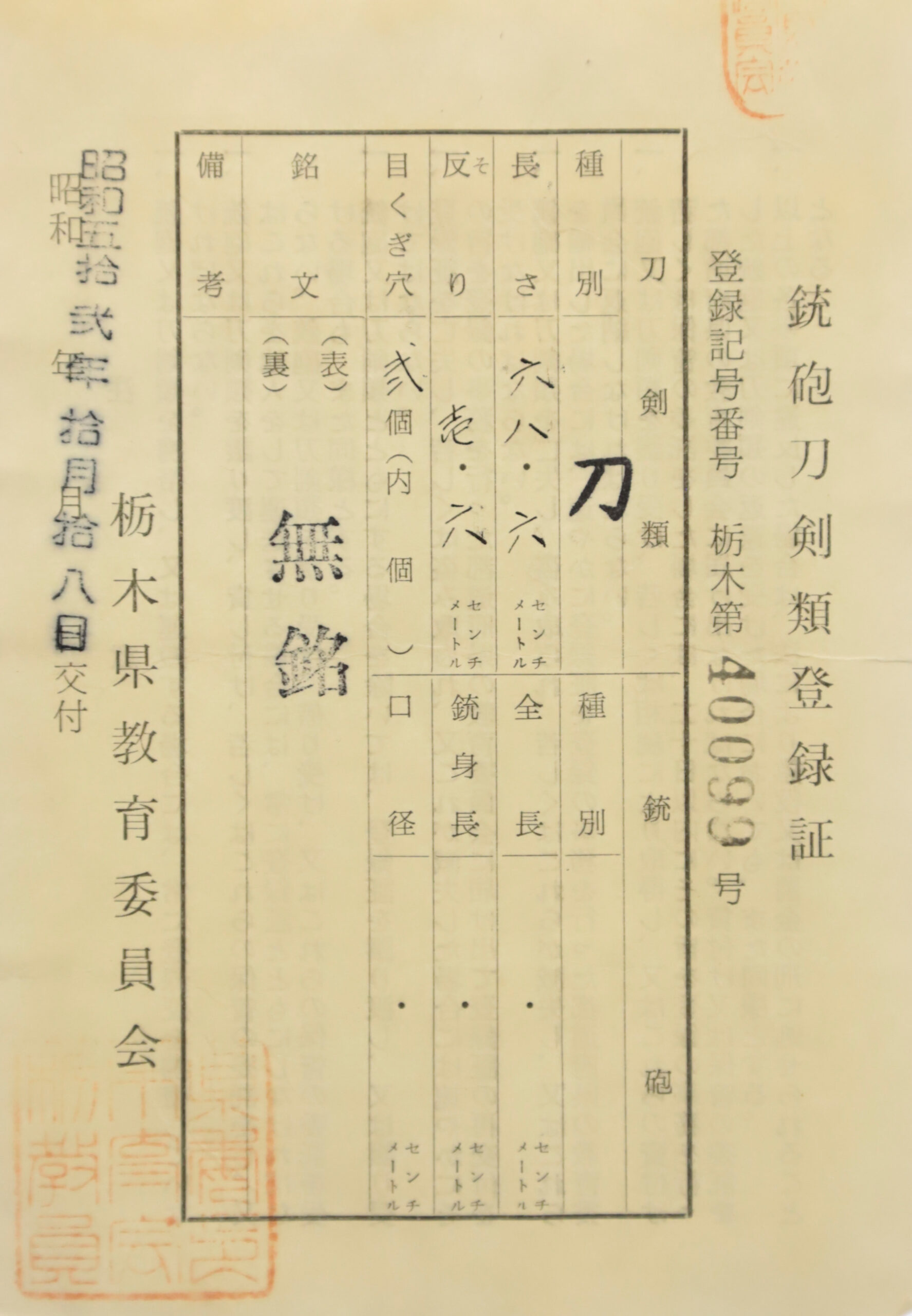
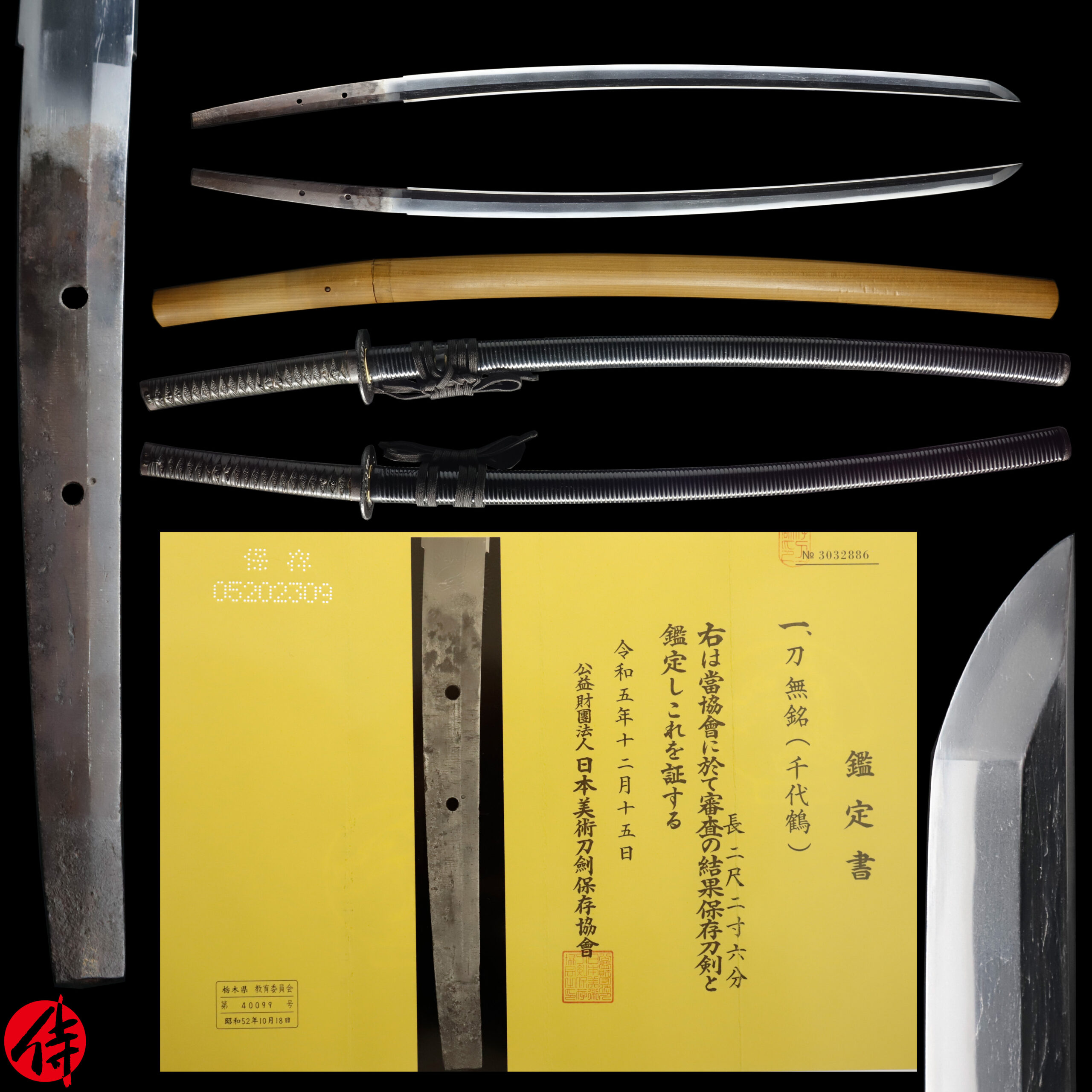
【About us】
Samurai Museum is located in Tokyo, Japan, exhibiting antique artifacts related to the Samurai history. Samurai Museum Shop is the place for those who are interested in Japanese culture and craftsmanship. We deal with antique Samurai swords/armor, traditional crafts made in Japan and so on.
【Japanese Sword& Export Process】
The Japanese swords we deal with are hand-forged edged swords made in Japan. It was made from the traditional carbon steel called TAMAHAGANE(玉鋼). Samurai Museum is familiar with the proper legal procedure for an antique/ authentic Japanese sword to be exported from Japan. We have sent more than 700 Japanese swords for the past few years (~2024) to amazing owners who appreciate its historical value.
Each Japanese sword is registered under the Agency for Cultural Affairs and the Board of Education in Japan. They issue a registration paper for each Japanese sword for its owner in Japan to legally possess it. The Japanese sword with its registration paper means it was traditionally hand-forged in Japan.
To legally export the sword from Japan to other countries, we will have to apply for its permit to the Agency for Cultural Affairs(Bunkacho) and return the original registration paper to the Board of Education. It normally takes around 2-4 weeks to receive this permit after submitting required documents. And we would like you to expect at least 1-1.5 months for your order to arrive at your given address after you ordered. For more detailed info, please click here.
It is allowed for residents in Japan to own authentic Japanese swords without a special license as long as they come with registration papers. Please feel free to contact us if you are a resident of Japan, whether temporarily or permanently. We will also assist you when you leave Japan and need to obtain the export permit.
【Payment Method】
We accept payment through Stripe (Credit card), PayPal, Apple Pay or ChromePay, all of which are secure payment methods. Also, you don’t need to make an account on Stripe for the checkout. If you prefer other payment method, please contact us. After confirming your payment, we will apply for an export permit. You may either pay in JPY, USD, AUD, CAD,EUR CHF or GBP. The price is set in Japanese Yen. Prices in other currencies are automatically calculated based on the latest exchange rate.

* If the amount is above 1 million JPY, Stripe or wire transfer will be the only options for payment.
【Shipping】
We have shipped authentic Japanese swords to the USA, UK, Canada, Mexico, Germany, France, Hong Kong, Finland and Australia. If you don’t live in these countries and like to order, please contact us first before making a purchase. We offer Free International Shipping as long as we can send antique Japanese swords by EMS.
We normally ship by EMS(Express Mail Service) provided by Japan Post. We will send you a tracking number for your order as soon as we hand it to the post office. We will put 100 % insurance on the shipping document without any extra charge. Based on the total amount, there might be a duty tax or other fee for you to pay, depending on the countries. We use package cushioning to protect the item and put it in a PVC pipe, which is one of the most secure packages because of its durability.
It will normally takes 5-14 days for the item to arrive at your given address after we dispatch it. Time of delivery is estimated as accurately as possible by the carrier but does not take into account any delays beyond our control such as by inclement weather, post office holiday seasons.
* If you live in Australia and like to purchase an authentic Japanese sword, please click here to know the detail.

【Review】
Here is one of the reviews we received from a customer who purchased an authentic Japanese sword from us. For more reviews, please click here.
“My experience overall with the whole process was wonderful. I had many questions about the history and process to purchase these treasures. All my questions were answered very timely and complete. The staff is very knowledgeable and very well versed if any questions do arise.”
【How to make sure the condition】
Please keep in mind that what you are going to purchase is an antique item. We uploaded high resolution photos for you to check its condition thoroughly. If you like to see more photos with different angles, please feel free to contact us. We will be happy to send them to you so that you can make informed decision. It is essential for us to know that you are happy with your choice of a sword. and we are prepared to use the best of our ability to serve you.
【How To Contact Us】
Please contact us through email, Facebook Messenger or Live Chat if you have any questions. You can find each icon on the right side of the website. Please click one of them to reach us. We will reply to you within 1-2 business days.
【The Art of Nihonto (Japanese Sword)】
Samurai’s history is a profound, eloquent legacy of ancient Japanese warriors in which millions of people worldwide are being fascinated. If you like to find out the art of Nihonto, please click here.
【A Guide to Japanese Sword Maintenance】
After acquiring an genuine Japanese sword, it is also important to know how to take good care of it. Here is the special video for you. Mr. Paul Martin, Japanese sword expert, shows you how to give proper maintenance to your sword. By mastering how to clean the Japanese sword, its aesthetic beauty will last forever.
When you purchase a Japanese sword from us, you can get a Free Japanese sword maintenance kit. It comes with four tools(Choji Oil, Uchiko Whetstone Powder, Peg remover, Oil Applicator). By watching the video instruction above , you can enjoy learning how to maintain your Japanese sword while appreciating it. If you have any difficulty assembling the sword or cleaning the blade, you can feel free to contact us.


MORE ANTIQUE JAPANESE SWORD FOR SALE
SWORDS WITHOUT CERTIFICATES FOR SALE
LEARN JAPANESE SWORD TERMINOLOGY
Thank you for reading all the information on the page. If you have any difficulty choosing the right Japanese sword for you, we will be more than happy to help you find the one that speaks to you the most. Please feel free to contact us.
